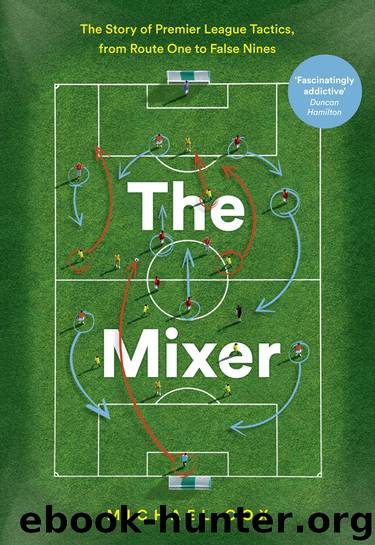The Mixer by Michael Cox

Author:Michael Cox
Language: eng
Format: epub
Publisher: HarperCollins Publishers
Published: 2017-04-20T04:00:00+00:00
15
The Midfield Trio
‘Gerrard and Lampard were both intelligent footballers. If one player went forward, the other had to stay back. It was not more difficult than that.’
Sven-Göran Eriksson
The most significant tactical change during the first few years of the 21st century was the shift towards one-striker formations, essentially started by Sir Alex Ferguson’s decision to switch from 4–4–2 to 4–5–1 in 2001. Although the initial focus was on the striker, suddenly forced to cope alone against two centre-backs, the midfield zone experienced an equally significant revolution.
After all, the reason for this shift was to beef up midfield with an extra man. As English clubs increasingly realised the importance of keeping possession in the centre – or, looking at it from a more reactive perspective, not being overrun in that zone – managers increasingly needed three central midfielders. It’s worth remembering Sir Alex Ferguson’s assessment of this zone in the 1990s. ‘In Europe they pass to each other in midfield,’ he said. ‘They play in little triangles and keep it there, they play one-twos against you in midfield, whereas our midfielders service the wide players, the full-backs and the frontmen.’ In the 1990s the primary instinct was to get the ball out of the midfield zone. In the 2000s it was all about keeping it there.
English football essentially embraced the European model, thanks to a variety of factors, including more foreign players, stricter laws about tackling – which benefited technical talents – and, crucially, a dramatic improvement in the quality of pitches. As late as the 1990s winter matches were often played on horrendous mud baths, which made good football almost impossible. Now, with slick bowling greens up and down the country, teams could trust the pitch and pass the ball.
In the days of two-man central midfields there were basically three types of combination. You could have two box-to-box midfielders, like a young Roy Keane and Paul Ince at Manchester United, you could have one player sitting in front of the defence and the other scampering forward into attack, like Lee Clark and Robert Lee at Newcastle, or you could have two defensive midfielders, like Patrick Vieira and Emmanuel Petit at Arsenal.
The three-man midfield made everything considerably more complex. For a start, the positioning of the midfielders took two different forms: always a triangle, but arranged in completely opposite ways. The 4–3–3, as popularised by José Mourinho, featured one holding player with the two others broadly playing box-to-box roles, whereas the 4–2–3–1 favoured by Rafael Benítez meant two players sharing defensive midfield responsibilities, often with some freedom to advance, and a proper number 10. That’s just the positioning of the players, too; their actual styles could vary wildly. The deepest midfielder could be a pure ball-winner like Javier Mascherano or a deep-lying creator like Michael Carrick, the ‘second’ midfielder could be a pure passer like Xabi Alonso or an enegetic all-rounder like Michael Essien, and the most attacking midfielder could be a driving, powerful player like Steven Gerrard or a playmaker like Tomáš Rosický.
Download
This site does not store any files on its server. We only index and link to content provided by other sites. Please contact the content providers to delete copyright contents if any and email us, we'll remove relevant links or contents immediately.
Relentless: A Memoir by Julian Edelman(1753)
Cristiano Ronaldo: The Biography by Guillem Balague(1466)
The Source by James A. Michener(1458)
ALEX FERGUSON My Autobiography by Alex Ferguson(1440)
1942 by Winston Groom(1404)
Football's Strangest Matches by Andrew Ward(1397)
When Pride Still Mattered by Maraniss David(1302)
Time's Champion by Time's Champion (Craig Hinton & Chris McKeon)(1213)
Chiefs by Stuart Woods(1210)
Where Men Win Glory: The Odyssey of Pat Tillman by Jon Krakauer(1139)
Gunslinger by Jeff Pearlman(1130)
0.721 by Gary Webster(1109)
Paterno by Joe Posnanski(1080)
Snake by Mike Freeman(1048)
Coming Back Stronger by Drew Brees & Drew Brees(1043)
Texas Monthly On… by Texas Monthly(1037)
League of Denial by Mark Fainaru-Wada(1014)
Deal Breaker by Harlan Coben(1008)
It Takes What It Takes by Trevor Moawad(983)
